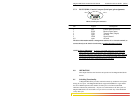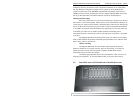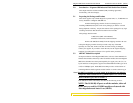
Magnum 6K8-Series Industrial Field Switch Installation and User Guide (04/07)
attempting to transmit to one 100Mb port, and in other protracted heavy traffic situations.
Magnum 6K8-Series Switches implement the 802.3x flow control (non-
blocking) on Full-Duplex ports, which provides for a “PAUSE” packet to be transmitted
to the sender when the packet buffer is nearly filled and there is danger of lost packets.
The transmitting device is commanded to stop transmitting into the 6K8-Series Switch
port for sufficient time to let the Switch reduce the buffer space used. When the available
free-buffer queue increases, the Switch will send a “RESUME" packet to tell the
transmitter to start sending the packets. Of course, the transmitting device must also
support the 802.3x flow control standard in order to communicate properly during
normal operation.
Note: When in Half-Duplex mode, the 6K8-Series Switch implements a backpressure
algorithm on 10/100 MB ports for flow control. That is, the switch prevents frames from
entering the device by forcing a collision indication on the half-duplex ports that are
receiving. This temporary “collision” delay allows the available buffer space to improve
as the switch catches up with the traffic flow. The flow control option may
(enable/disable) through setport command of MSN-6K software as per the requirement of
network. By default the Flow control is disabled.
4.5 Power Budget Calculations for Magnum 6K8-Series PM’s with
Fiber Media
Receiver Sensitivity and Transmitter Power are the parameters necessary to
compute the power budget. To calculate the power budget of different fiber media
installations using Magnum products, the following equations should be used:
OPB (Optical Power Budget) = P
T
(min) - P
R
(min)
where P
T
= Transmitter Output Power, and P
R
= Receiver Sensitivity
Worst case OPB = OPB - 1dB(for LED aging) - 1dB(for insertion loss)
Worst case distance = {Worst case OPB, in dB} / [Cable Loss, in dB/Km]
where the “Cable Loss” for 62.5/125 and 50/125
m (Mm) is 2.8 dB/km,
and the “Cable Loss” for 100/140 (Multi-mode) is 3.3 dB/km,
and the “Cable Loss” for 9/125 (Single-mode) is 0.5 dB/km
and the “Cable Loss” for 9/125 (Single-mode) is 0.4 dB/km (LXSC25)
and the “Cable Loss” for 9/125 (Single-mode) is 0.25 dB/km
(LXSC40)
and the “Cable Loss” for 9/125 (Single-mode) is 0.2 dB/km (LXSC70)
The following data has been collected from component manufacturer’s (Agilent’s and
Lucent’s) web sites and catalogs to provide guidance to network designers and installers.
47
www GarrettCom com
..


















